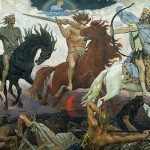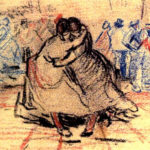We run our website the way we wished the whole internet worked: we provide high quality original content with no ads. We are funded solely by your direct support. Please consider supporting this project.

Jesus Came to Bring a Sword?
Jesus said: “Do not suppose that I have come to bring peace to the earth. I did not come to bring peace, but a sword” (Mt 10:34).
Some, both modern scholars along with church leaders since the fourth century, have used this passage as evidence to argue that Jesus is not altogether non-violent.
When we place Matthew 10:34 in its broader context, it becomes clear that Jesus’ teaching not only does not condone violence on the part of his disciples, it actually rules out all violence. As Jesus is preparing his disciples to proclaim the Good News of the arrival of the kingdom of God throughout the region, he warns them that he is sending them out “like sheep among wolves” (Mt 10:16, cf. vv. 5-15). He tells them they will be “handed over to the local council,” “flogged in synagogues,” and “brought before governors and kings” (vv. 17-18). Moreover, Jesus warns them that their ministry is going to upset the entire social order. “Brother will betray brother to death, and a father his child,” while “children will rebel against their parents and have them put to death” (v. 21). And, Jesus adds, “[y]ou will be hated by everyone because of me” (v. 22). If the master is persecuted and called “Beelzebul,” he says, his servants must expect the same (vv. 21-3). But in all this the disciples are to trust their heavenly Father, even when they face death (vv. 26-31). Jesus then stresses the importance of disciples fearlessly proclaiming the message he has given them, telling them that he will “acknowledge before my Father in heaven” everyone who “acknowledges me before others” (v. 32). On the other hand, Jesus will “disown before my Father in heaven” anyone who “disowns me before others” (v. 33).
It is at this point that Jesus tells his disciples, “I did not come to bring peace, but a sword” (v. 34). When understood in its broader context, it is apparent that Jesus is simply using the image of the sword as a hyperbolic metaphor for the division that the message of the kingdom would bring, which, significantly enough, is how Luke interprets this metaphor (Lk 12:51-2). Jesus is simply telling his disciples not to be surprised or intimidated by the fact that the message of the kingdom is going to cause social upheaval and may even divide the disciples’ own households and result in their martyrdom.
This point is further driven home in the passages that immediately follow this teaching and that clarify its meaning. Jesus first quotes the prophet Micah who spoke of a similar time of social upheaval in Israel. Jesus declares that the message of the kingdom of God will set…
a man against his father,
a daughter against her mother,
a daughter-in-law against her mother-in-law—
a man’s enemies will be the members of his own household (Mt 10:35-6, cf. Micah 7:6).
And then, again driving home the urgency of remaining faithful to Jesus even when being rejected by one’s own family, Jesus tells his disciples that if anyone “loves their father or mother more the me” they are “not worthy of me” (v. 37). So too, he adds, “[w]hoever does not take up their cross and follow me is not worthy of me,” and “[w]hoever finds their life will lose it,” while “whoever loses their life for my sake will find it” (vv. 38-9).
This is the “sword” that Jesus brings to the world. And it is clear that, while this “sword” involves not only division, but violence, none of the violence is carried out by the “sheep” Jesus is sending out. It is rather carried out by “wolves” who engage in violence against the “sheep,” which is precisely why Jesus instructs his disciples to be fearless in the face of death and to take up their cross, as he himself would do in the near future.
In this light, I think it is apparent that those who have appealed to this passage to justify violence throughout history were twisting it to fit their own violent aspirations. And this is confirmed by the fact that it never occurred to anyone to use this passage in this way until the church tragically aligned itself with the power of the State, and thus with the power of the sword, in the fourth and fifth centuries.
Photo credit: h.koppdelaney via Visual Hunt / CC BY-ND
Category: General
Tags: Conflict, Jesus, Non-Violence, Peace
Topics: Enemy-Loving Non-Violence
Verse: Matthew 10
Related Reading

Reflections on the Supremacy of Christ (Part 2)
Whereas most Christians place the revelation of God in Christ alongside of other portraits of God and end up with an amalgamated image of God, we at ReKnew encourage believers to base their understanding of God completely on Christ, and especially on Christ crucified. And we encourage disciples to work to reinterpret through the lens…

Is the Jesus of Revelation Wrathful?
In the second coming of Jesus, will he turn with wrath? Will he come as a roaring lion, ready to put on his display all of his anger, power, and might? What does the Jesus revealed in Revelation look like? This is a short clip that addresses these questions. If you want to watch the…

Benefit of the Doubt Is Here!
Benefit of the Doubt is finally here and you should definitely get yourself a copy! Frank Viola interviewed Greg about the book recently and you can read it over on Frank’s blog Beyond Evangelical. In fact, Frank is so enthusiastic about the book that he added it to his Best 100 Christian Books Ever Written list. Wow. Also,…

What to Do If You See God as Violent
God really is as beautiful as he is revealed to be on Calvary. Communicating this is my goal in everything I write—especially Crucifixion of the Warrior God and Cross Vision. But for many, to see him as being that loving, is not easy. We have to make a concerted effort for our brains to adjust…

Unpacking Revelation: Is it Literal?
According to many scholars as well as many Christian laypeople, the Jesus we find in the book of Revelation engages in a great deal of violence. This violence reaches a zenith in chapter 19 where we find Jesus going out to make war on a white horse (v. 11). He is dressed in a blood…

What Does It Mean to Be Married to Christ?
The New Testament calls Christ the “bridegroom” and the church his “bride.” To understand what this means can change your life. We need to read this through the lens of first century Jewish marriage. In what follows we’ll highlight six aspects of first century Jewish marriages to see how each sheds light on the New…
